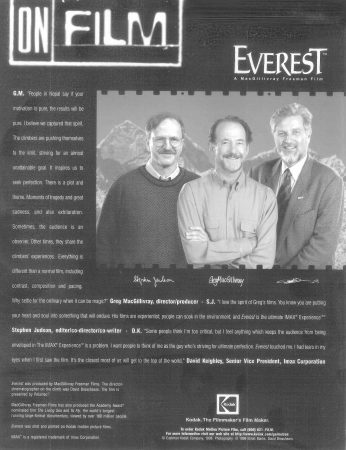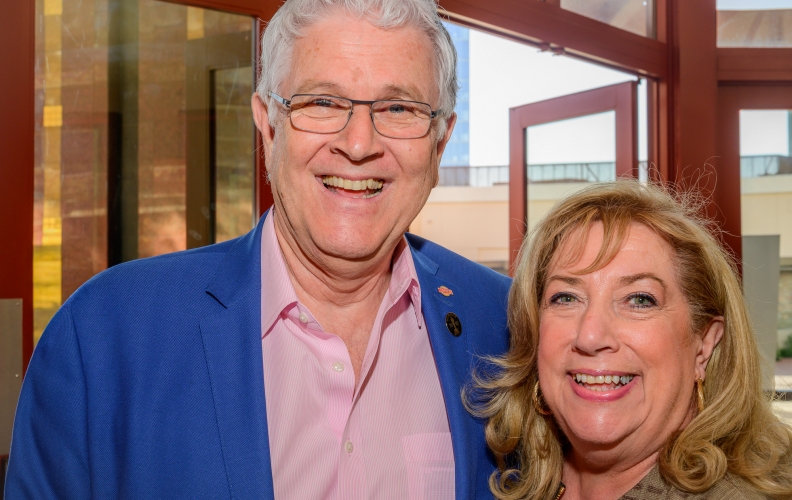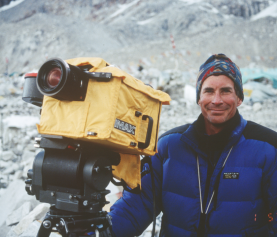By Greg MacGillivray
As our team at MacGillivray Freeman Films mourns the loss of our dear friend and IMAX icon, David Keighley, we want to share what David meant to us, to our company, and to the giant-screen industry that his genius helped shape.
David was responsible in so many ways for the thrill that millions of moviegoers have felt watching films on the IMAX screen. A master of his craft, he combined the mind of a brilliant engineer with the eye of a true artist, delivering by the far the finest printmaking work our industry has ever seen.
From our very first collaboration on To Fly! in 1976 through nearly 50 giant-screen productions, David always pushed for perfection. Because of his skill in creating flawless prints with perfect color and contrast, the IMAX format earned a reputation for quality that became second to none. His work elevated every film he touched and ultimately helped build an industry of devoted fans and audiences around the world.
For many years, we were the only production company that made all our prints directly from the original negative, a demanding process that required extra work, cost, and time. David never hesitated—he embraced the challenge because he believed audiences deserved nothing less than the very best experience.
With our record-breaking film Everest, David achieved what seemed impossible: delivering 100 immaculate IMAX prints within the first three months of release. Each was a work of art, struck from the original negative shot on the mountain so audiences could feel every detail of being on the summit. He and his crew, especially Scott Price, worked tirelessly—day and night for months—to make it happen. It was the first time any film had opened in that many IMAX theaters at once, a turning point for the industry. Ultimately, David would produce more than 265 prints of Everest, each one reflecting his insistence on perfection.
Over the decades, David helped us get through many challenging situations. When mysterious tiny bubbles appeared on IMAX prints made from Kodak film stock, David pored over every detail, working seven days a week for four months to solve the problem. At another time, when our prints suddenly lost their rock-steady alignment, David was the one who solved the problem, tracing the issue to a new way Kodak slit their film. Each time, he applied both science and artistry to problems no one else could unravel. Again and again, he saved films, protected the IMAX standard, and strengthened our industry.
Most of all, David was a true friend. Just six weeks ago, he agreed to help me with a new film project later this month. I will miss him immeasurably – his sharp eye, his wise counsel and most of all, his friendship. Our industry would not be what it is today if it weren’t for the expertise, artistry and sheer force of David Keighley. He made the impossible possible—and he made all of us better.

Where to Begin Describing David Keighley?
By Matthew Muller, MFF Post-Production Coordinator
Where to begin describing David Keighley and his impact? Perhaps at the beginning.
I started working for Greg MacGillivray as an assistant editor on MFF’s second IMAX film, Behold Hawaii, in 1981, and met David soon after. At that time, David was working alone, sharing a room with Bill Pine in the timing trailer at Metrocolor in Culver City. I remember he had to argue with the union for the right to roll cans of film by himself on a hand truck from the loading dock to his room or wherever needed. “Watch the truck!!” he would cheerily call out as he neared a corner or doorway.
David worked closely with Greg on every film, and I had the privilege of gaining career-long technical training under David’s tutelage. As our films grew more sophisticated and demanding, and as my position and responsibilities expanded, David and I would find ourselves in the trenches, collaborating during the final grueling months of post-production. It was always David’s dedication and iron determination that kept us on track, along with his ability to pull off miracles.
After Metrocolor folded, there was a mad scramble to find another lab capable of serving the large format industry to the high technical standards that David insisted on. He helped Technicolor and Deluxe do so during those transitional years until CFI came on line as the new state-of-the-art lab for IMAX and LF films. Working with scientists at Kodak, lab heads and technicians, and eventually forming DKP 70mm with Patricia, David didn’t just support filmmakers like us–he empowered us. He made it possible for our craft to be displayed more beautifully, more evocatively, on the growing number of IMAX screens around the world.
I can’t count how many times David solved the unsolvable, or figured out the path forward, or forged a new path, to help achieve Greg’s vision on our dozens of films. Personally, I am deeply in debt for the number of times he saved my skin when MFF’s schedules ran late…and later…and later yet. I’m convinced he had a secret farm somewhere because I swear he regularly pulled rabbits out of his hat!
David had a gruff exterior, though he maintained he was a “teddy bear” underneath (I’m sure Patricia had a hand in THAT!), and I was lucky to share that warmth. We had a common curmudgeonly outlook on the world, and he’d often call me on his drive home to check in, maybe vent a bit, and we’d always manage to share a giggle or even a guffaw. I’m honored to know David regarded me as a peer, but even more, as a friend.
David was a true one-of-a-kind, a technical wizard, an industry Force, the sine qua non that we, that the industry, depended on. He will be missed.
TOP PHOTO: David and Patricia Keighley. PHOTO CREDIT: Matthew Muller.






